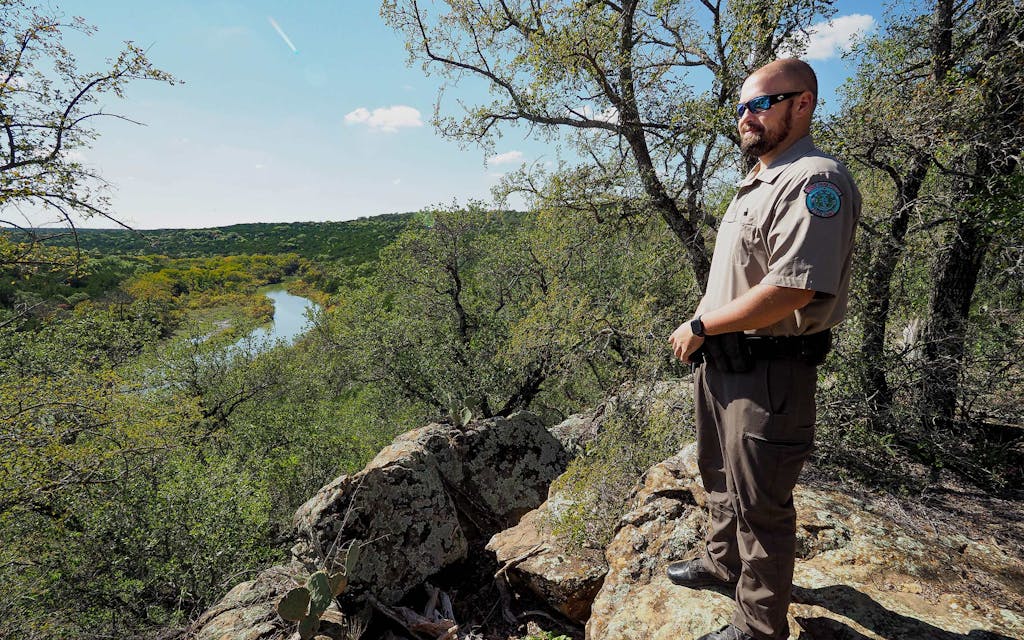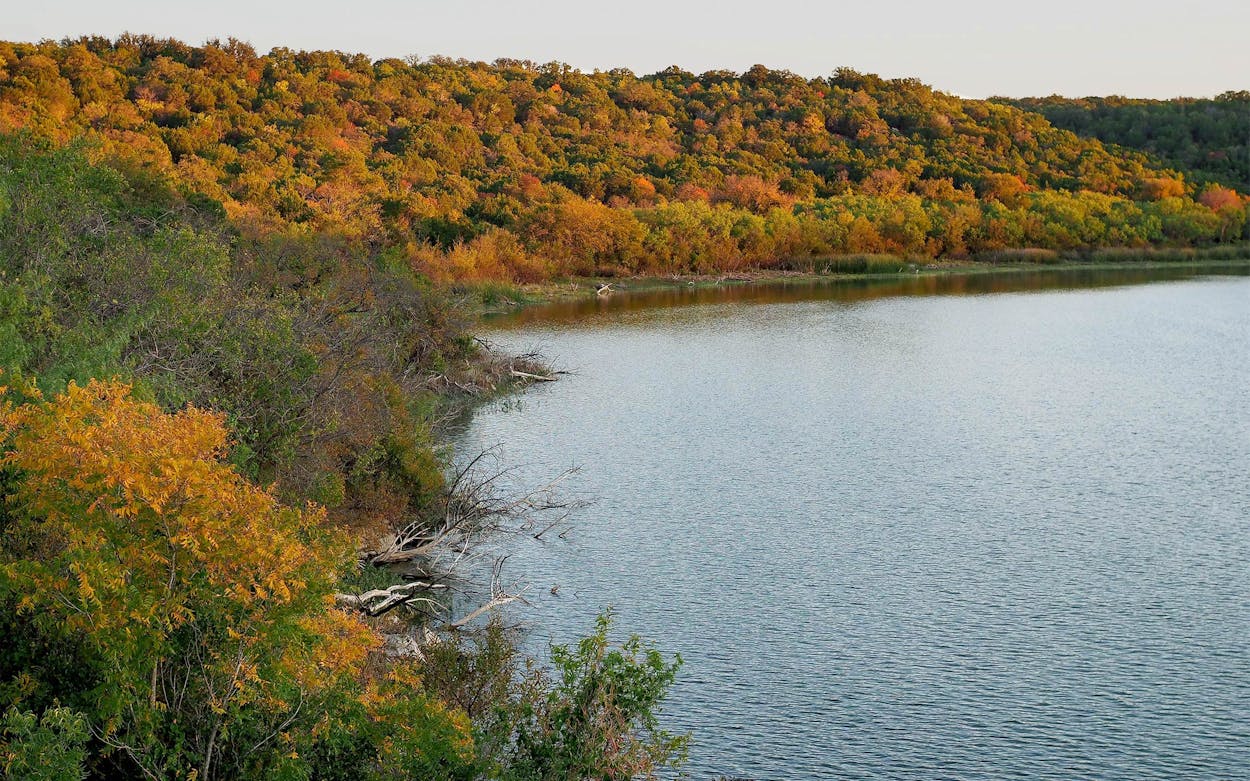I’m standing on a ridge at what will become Texas’s next state park, almost exactly halfway between Fort Worth and Abilene. At this rocky, brush-covered overlook, a creek twists like a curled strip of lime peel far below. Oak trees bow over the ribbon of green, while thick prairie grasses, juniper, and mesquite lend an almost junglelike feel to the rolling terrain. I can hear the tractors that are grading new park roads rumbling in the distance, but when I look out, all I see is untouched land.
I can picture myself paddling a kayak down there. After a few hours of exploration, I’d drag my boat ashore. Then I’d scamper up the road to this future campsite, where I’d grab a cold drink and enjoy the view from a folding chair in front of my tent.
When the gates at Palo Pinto Mountains State Park swing wide sometime later this year, this rolling terrain will become the ninetieth state park in Texas. The 4,871-acre parcel, located about eighty miles west of Fort Worth and eighty miles east of Abilene, will give Texans a new place to hike, bike, fish, swim, and ride horses. In a state that’s home to more than 30 million people, yet where only about 5 percent of the land is publicly owned, the new park can’t open fast enough. It will be North Texas’s first new state park in 25 years.
I’ve come to Palo Pinto, which officials say will have a soft opening in late 2023, to get an idea of what it offers. So far, it looks great. Alongside the creek whose fingers twist down below, there are sprawling hills that will soon be crisscrossed by trails for biking, hiking, and horseback riding. These picturesque vistas look more like the Hill Country of Central Texas than the flatter expanse I’d expected.
Still, to call Palo Pinto’s hills “mountains” makes me chuckle. Topping out at just 1,400 feet, these little peaks are dwarfed by the mountains of West Texas, much less the 14,000-foot crowns of Colorado. By comparison, Guadalupe Peak, the highest spot in Texas, rises 8,751 feet above sea level.
“Big hills would probably be a more accurate description,” says park superintendent James Adams, who transferred from Cooper Lake State Park, outside Sulphur Springs. “They do fall short of the conventional definition of mountains.”
Regardless, this place is beautiful—and has a long history. Native tribes including the Caddo and Tonkawa once roamed the area, and if you look closely at the earth beneath your feet, you just might see something they left behind. Archaeologists have turned up projectile points thousands of years old and dated a campsite at about 3,500 years old, Adams says.
We take in the view at the overlook for a few more minutes, then head back to Adams’s white pickup. From there, we bounce along a dirt road as earth-moving tractors and trucks growl past. We descend from the plateau, where most of the campsites will be located, then chug up another hill, where I drink in the tranquil sight of ninety-acre Tucker Lake.
This calm, quiet lake is the centerpiece of the park. The Works Progress Administration built it in the late 1930s as a water source for the nearby city of Strawn, which the lake still supplies. In the 1950s, the Strawn Recreation Club formed, and the city leased some of the land around the lake to club members, who built small cabins. Sometime in the 1980s, the city council voted not to renew the club’s lease, and most of the dozen or so structures were torn down. Workers with Texas Parks and Wildlife removed the remaining two cabins after construction began on the new park in January 2021.
As I look at the lake now, I can envision swimmers splashing along its shoreline, canoes gliding across its placid surface, and anglers casting from a dock. Fishing boats powered by trolling motors (but no motorboats) will be allowed here, and the park may offer kayak rentals.
“There’s a need for parks everywhere in Texas,” Adams says. “And the topography here is so unique. There’s lots of rich history with the railroad and Indigenous people and ranching.” Legendary cattle baron Charles Goodnight was among the wave of landowners who purchased ranchland in this region in the 1850s. Mineral Wells, a former spa destination that is making a comeback, is about forty minutes away.
The state acquired the first 3,300 acres for the park in 2011. During my visit, crews are grading the foundation of what will become the future park’s headquarters building. When construction is complete, most likely in 2024, the park will have a slew of amenities: two bathhouses, a boat ramp, a floating dock, several no-water restrooms, a pavilion, and playscapes for kids. The rest will remain wild, with thickets of mesquite, cedar elm, pecan, oak, and Ashe juniper interspersed with pocket prairies blooming with wildflowers. The park is on the migration route for monarch butterflies; visit in October, and you may be lucky enough to glimpse clouds of the orange-and-black insects as they pass through.
The park’s planners have struck a careful balance between conservation and development, ensuring that Palo Pinto will be accessible and enjoyable for Texans of all ages and walks of life while still preserving the wilderness. About eighteen miles of trails for hiking, biking, and horseback riding will crisscross the grounds. Fifty-nine campsites, including some primitive sites two miles from the parking area and one site designed to accommodate horses, will be available for overnight visitors. “We expect the park to be a popular equestrian destination,” Adams says.

Palo Pinto is located a few miles southwest of the city of Strawn. This rural community grew in the 1880s, when the Texas and Pacific Railway arrived. Today railroad tracks still run parallel to part of the park’s boundary. We hop out of the pickup and scramble down to a dry creek bed to get a closer look. An old rock oven once used by the workers who built the tracks still exists, along with some other hard-to-find building ruins, Adams says. One of the park’s trails will lead to a low dam on Palo Pinto Creek, where hikers will be able to see what’s left of an old pump that was used to fill passing steam engines.
Back in the truck, we descend an incline and Adams points to a series of hills in the distance. “This is what makes it special,” he says. “We’ve got tons of great views, really cool terrain changes, and the location is great.” That’s crucial for the nearly 90 percent of Texans who now live in metropolitan areas. Abilene is about an hour away by car, while Dallas is roughly two hours. Lubbock and San Antonio are each about four. Adams promises that the new park will be worth the trip, no matter your favorite outdoor activity: “Palo Pinto has something for anglers, hikers, paddlers, equestrians, photographers, and trail runners.”
Starting a new park is a Herculean endeavor, one that the state can’t pull off alone. The Texas Parks and Wildlife Foundation raised roughly $9 million to supplement about $21 million in public funding for Palo Pinto. And a nonprofit called Palo Pinto Mountains State Park Partners has already formed to support the park through fund-raising and volunteer manpower.
In Strawn, I meet longtime resident and city secretary Danny Miller, who serves as the group’s president. He tells me most of the city’s roughly six hundred residents are excited about the park’s coming opening. Strawn contributed about 120 acres of land, plus a 99-year lease on the surface rights of the lake, to create the park, he says. The city retains ownership of the water, and under an agreement with the state, the park’s entrance road will start in Strawn. The destination is expected to draw between 75,000 and 100,000 visitors per year. It’ll be a big change for this quiet community.
“Strawn in my entire memory has been the same size, with about the same number of businesses,” Miller says. “Now we’ve got this opportunity for tourism coming in.”
Miller has fond memories of the parkland. When he was a boy, he would pay $1 to fish from the dock at Tucker Lake. Sometimes he’d walk along Russell Creek. “When it was full, we could go a mile up that creek and see a different world, with trees hanging over the creek,” he recalls. He’d hunt for Easter eggs at the small roadside park within the new park’s boundaries. Once, when it flooded, he and his friends tubed along Russell Creek from the park to the city of Strawn. They saw water moccasins and trees snagged along the banks. “At one point, an alligator gar flopped up onto one friend’s lap, and he jumped off at the shock of it. We had to go pick him up later,” he laughs.
The nonprofit, he says, will work to raise the park’s profile and support park operations. Its roughly one hundred members have already raised money to make improvements to a storage barn behind the superintendent’s house. They plan to host cleanups, maintenance projects, and other events, and they might someday open a park store too.
“I’m excited from the city side, because it’s going to help Strawn grow, and put us on the map,” Miller says of the upcoming opening. He sees the park as Strawn’s fourth boom, after the arrival of the railroad, the discovery of coal, and the extraction of oil.
Today, he says, one of Strawn’s biggest claims to fame is Mary’s Cafe, which tops several rankings of the best chicken-fried steaks in Texas. The restaurant serves huge portions, and even a steak described on the menu as “small” drapes over the edge of a plate. Unlike most chicken-fried steaks, which are deep-fried, the ones at Mary’s are cooked flat on a griddle, which Miller and I agree is the way to go.
The opening of the park will bring more business to the beloved cafe, he predicts. “Mary may need to open Mary’s Number Two,” Miller says. “Texas Parks and Wildlife Department breathed new life into Strawn.”
- More About:
- Parks & Recs






